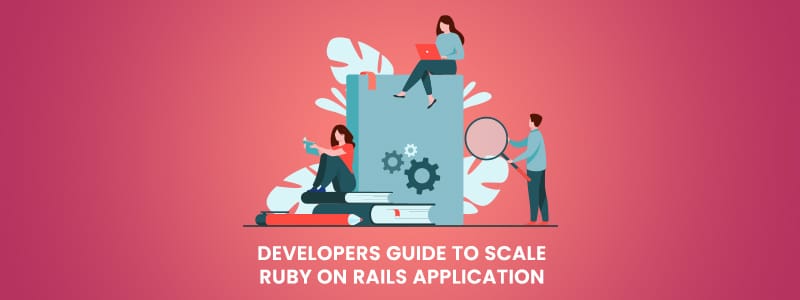For the creators of the application, having so many users is both a success and a challenge. The first thing you need to do is deal with the growing interest in your product or service. Conversely, insufficient technical preparation can lead to the collapse of the application. It is fortunately possible to solve this problem. You will learn how to scale your Ruby on Rails application with our help.
How scalable is the framework?
Scaling a framework means increasing the application’s capacity to generate more requests per minute (RPM). It is less important to take care of the framework itself than the infrastructure of the entire server system. See how this works in practice.
Consider a skyscraper with only one elevator that can accommodate a few people. It gets so crowded in the elevator that it can’t function properly due to the high interest in enjoying the landscape. Before the building is completed, it is essential to ensure that proper infrastructure is in place or to develop a method for transporting more people to the top. The elevator described here is equivalent to an application without the appropriate scaling. Losses are incurred as a result, which can be extremely painful.
What will happen if you don’t scale your application?
When applications do not scale as traffic grows, they can become slow and even crash. This is only the beginning of possible problems. Customers may leave if a solution is delayed, and their dissatisfaction will be reflected in online reviews. Scaling should be improved quickly, not downplayed.
When scaling your application, what obstacles might you face?
Getting started with scaling is easy, but implementing it is difficult. Application architecture may be one of the obstacles. There may be problems with request handling, for example, if solutions that find themselves in reality of high interest have not been implemented. A clean, modular code is recommended for RoR applications.
Integration with more database management systems is favored by this approach. In addition, it is not a problem to place load balancers in order to handle more requests.
Is Ruby on Rails scalable?
Consequently, Ruby applications can be scaled easily. Due to the language’s horizontal scaling capabilities as well as its thread-safe nature, there are two reasons for this. Basically, you just need to launch more Ruby processes and connect more servers to your application to handle more traffic.
Tips to Scale Your Ruby on Rails Application
While some of them are specific to Ruby on Rails, others can be applied to any shared-nothing application server.
- The first rule is to cache, cache, cache, and cache some more.
Data can be cached at the client and streamed into the browser using Ajax libraries like JQuery. Learn how to use expiration and etags, and how to cache HTTP responses using gateway / reverse proxy caches. Take advantage of Rails’ built-in caching for actions, pages, and fragments. Your database results can be cached using Memcache instead of pulling them from it.
- Separate the data from the data serving
Don’t put all your data into one database “for convenience.” Separate databases should be used for datasets that are independent. Make static assets available through a separate tier, or use Amazon S3 or Akamai to deliver them. The cost is higher, but scaling is easier. Discuss with your DBA whether a relational data model is necessary for all your data stores, since relational databases scale up, not out. If your data is simpler, you might be able to use a key-value data store. When storing and analyzing large amounts of unstructured data, use Hadoop because there are Ruby clients. If you’re using a file system, you should also be aware of its scalability limitations. Use a copy of your main database instead of your production database if you have heavy data reporting needs.
- Minimize and manage external dependencies
Make sure the site does not depend on external services like ad networks or RSS feeds. Make sure you have a backup plan in case a service does not respond or cannot handle your growing request volume.
- Keep your job handlers and database up to date
SQL queries generated by any ORM, including Rails’ ActiveRecord, can cause database performance problems. If you have done a major integration, make sure you check your slow query log to ensure that there are no “missing” database indices and that your Rails code doesn’t contain inappropriate find-alls. You should periodically check your database to see if any indices are no longer needed. Watch the resource usage of your scheduled and background jobs as well.
As It is not uncommon for jobs to overlap as your user base grows, and daily log processing can begin to take more than 24 hours! It’s easy to be caught unawares by this kind of thing. Make sure your jobs are segregated into separate tiers. Eventually, you may want to move to a message-based job handler as your business grows.
- Your unavoidable relational data should be sharded
MySQL databases must be sharded at high scaling levels. The process of sharding involves breaking up your dataset into independent pieces based on a key. Sharding based on user ID can be used for most consumer-oriented Rails sites, but there are also sharding schemes based on data age or access frequency.
Conclusion
Depending on the type of project, Ruby on Rails-based applications should be scaled differently. As with many other technologies, RoR is not the answer to all problems. Thus, it is important to compare your business profile with Rails’ capabilities before developing an application. We recommend working with Ruby on Rails Development company Railscarma if you need expert RoR support. Every stage of application development will be handled by our experienced team of professionals.





